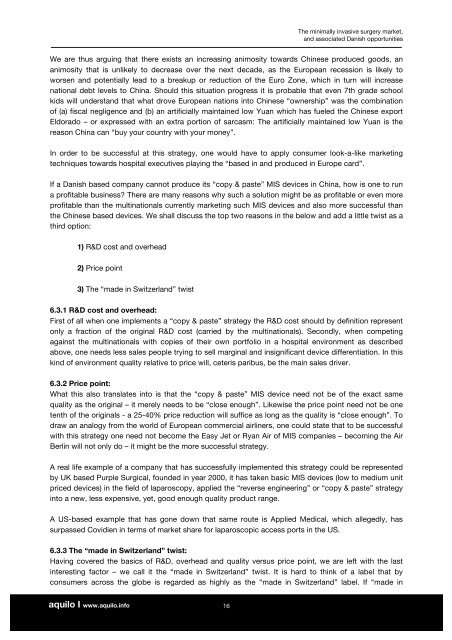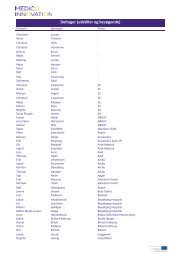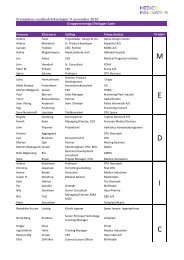The minimally invasive surgery market, and associated Danish ...
The minimally invasive surgery market, and associated Danish ...
The minimally invasive surgery market, and associated Danish ...
Create successful ePaper yourself
Turn your PDF publications into a flip-book with our unique Google optimized e-Paper software.
aquilo I www.aquilo.info<br />
16<br />
<strong>The</strong> <strong>minimally</strong> <strong>invasive</strong> <strong>surgery</strong> <strong>market</strong>,<br />
<strong>and</strong> <strong>associated</strong> <strong>Danish</strong> opportunities<br />
We are thus arguing that there exists an increasing animosity towards Chinese produced goods, an<br />
animosity that is unlikely to decrease over the next decade, as the European recession is likely to<br />
worsen <strong>and</strong> potentially lead to a breakup or reduction of the Euro Zone, which in turn will increase<br />
national debt levels to China. Should this situation progress it is probable that even 7th grade school<br />
kids will underst<strong>and</strong> that what drove European nations into Chinese “ownership” was the combination<br />
of (a) fiscal negligence <strong>and</strong> (b) an artificially maintained low Yuan which has fueled the Chinese export<br />
Eldorado – or expressed with an extra portion of sarcasm: <strong>The</strong> artificially maintained low Yuan is the<br />
reason China can “buy your country with your money”.<br />
In order to be successful at this strategy, one would have to apply consumer look-a-like <strong>market</strong>ing<br />
techniques towards hospital executives playing the “based in <strong>and</strong> produced in Europe card”.<br />
If a <strong>Danish</strong> based company cannot produce its “copy & paste” MIS devices in China, how is one to run<br />
a profitable business? <strong>The</strong>re are many reasons why such a solution might be as profitable or even more<br />
profitable than the multinationals currently <strong>market</strong>ing such MIS devices <strong>and</strong> also more successful than<br />
the Chinese based devices. We shall discuss the top two reasons in the below <strong>and</strong> add a little twist as a<br />
third option:<br />
1) R&D cost <strong>and</strong> overhead<br />
2) Price point<br />
3) <strong>The</strong> “made in Switzerl<strong>and</strong>” twist<br />
6.3.1 R&D cost <strong>and</strong> overhead:<br />
First of all when one implements a “copy & paste” strategy the R&D cost should by definition represent<br />
only a fraction of the original R&D cost (carried by the multinationals). Secondly, when competing<br />
against the multinationals with copies of their own portfolio in a hospital environment as described<br />
above, one needs less sales people trying to sell marginal <strong>and</strong> insignificant device differentiation. In this<br />
kind of environment quality relative to price will, ceteris paribus, be the main sales driver.<br />
6.3.2 Price point:<br />
What this also translates into is that the “copy & paste” MIS device need not be of the exact same<br />
quality as the original – it merely needs to be “close enough”. Likewise the price point need not be one<br />
tenth of the originals - a 25-40% price reduction will suffice as long as the quality is “close enough”. To<br />
draw an analogy from the world of European commercial airliners, one could state that to be successful<br />
with this strategy one need not become the Easy Jet or Ryan Air of MIS companies – becoming the Air<br />
Berlin will not only do – it might be the more successful strategy.<br />
A real life example of a company that has successfully implemented this strategy could be represented<br />
by UK based Purple Surgical, founded in year 2000, it has taken basic MIS devices (low to medium unit<br />
priced devices) in the field of laparoscopy, applied the “reverse engineering” or “copy & paste” strategy<br />
into a new, less expensive, yet, good enough quality product range.<br />
A US-based example that has gone down that same route is Applied Medical, which allegedly, has<br />
surpassed Covidien in terms of <strong>market</strong> share for laparoscopic access ports in the US.<br />
6.3.3 <strong>The</strong> “made in Switzerl<strong>and</strong>” twist:<br />
Having covered the basics of R&D, overhead <strong>and</strong> quality versus price point, we are left with the last<br />
interesting factor – we call it the “made in Switzerl<strong>and</strong>” twist. It is hard to think of a label that by<br />
consumers across the globe is regarded as highly as the “made in Switzerl<strong>and</strong>” label. If “made in







